Multiple Spaces in Screen Paintings
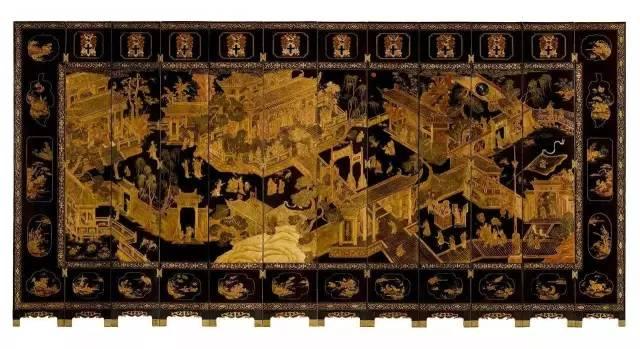
The screen is a physical object, a painting medium, a painting image, or all three. Due to the multiplicity of the screen, it gave ancient painters endless opportunities to recreate their art.
Recognizing the existence of this tradition can help us understand the creative intentions and painting techniques of ancient artists. For example, Zhou Wenju and Wang Qihan, the authors of "Playing Chess on Double Screen" and "Scanning Books", both served in the Southern Tang court. They both used screens as a key painting medium, but their creative intentions were completely different.
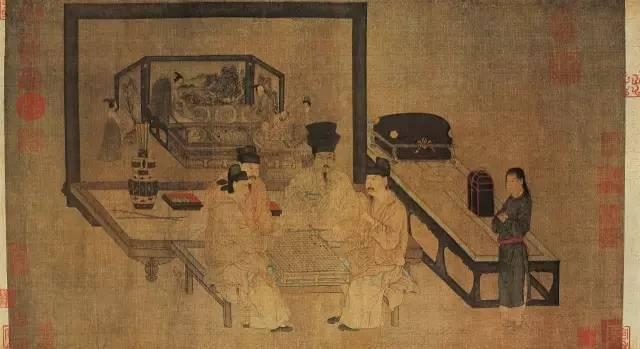
Five Dynasties/Zhou Wenju/Double Screen Chess Game
Color on silk 40.3×70.5cm /Collection of the Palace Museum
The Double Screen Chess Game depicts a scene of Li Jing, the Zhongzhu of the Southern Tang Dynasty, playing chess with his brothers, Jingsui, the Prince of Jin, Jingda, the Prince of Qi, and Jingti, the Prince of Jiang. The elder in the middle, wearing a tall hat and watching the game, is Li Jing, the Zhongzhu. He looks taller than the others. He holds the chessboard in his hands and looks at his eyes, as if thinking about something. The two people sitting sideways on the Hu bed playing chess are Jingda and Jingti, who observe each other. The person watching the game next to the Zhongzhu is Jingsui.
On the couch behind the Hu bed, there are pitching pots and chess boxes, creating a simple and elegant environment. Behind the bed, there is a large rectangular right-angled screen, on which is painted the poem "Occasional Sleep" by the Tang Dynasty poet Bai Juyi, depicting an old man lying on the bed, a woman standing behind him, and three maids spreading the blanket with a mattress. Behind the bed, there is another three-fold screen with landscapes painted on it. Therefore, the picture is a "chess game" and a screen is painted within the screen, so it is named "Double Screen Chess Game".
The Chess Game on the Double Screen is one of the most confusing compositions in traditional painting. The painter deliberately confuses the viewer and misleads the viewer to believe that the inner room scene on the screen is part of the real world. Here, the screen is both a frame and a boundary that connects and separates the space, and organizes the scattered spatial images into a complete picture.
This feature of using screens to cut into the picture also appears in "Night Banquet of Han Xizai" . Each part of "Night Banquet of Han Xizai" is an independent spatial unit. Its sense of depth is mainly formed by the symmetrical arrangement of furniture, especially screens. The oblique extension lines of these objects roughly meet on the center line of each part. This feature is obviously similar to the stone portrait of Zhu Yu. However, the division and connection, interruption and continuity of the scenes of each part are realized through the image of the screen, which obviously has the schematic characteristics of the figure picture on the colored box unearthed in Lelang.

Night Banquet of Han Xizai - Listening to Music
Five Dynasties - Southern Tang /Gu Hongzhong /Horizontal scroll 28.7cm vertical, 335.5cm horizontal
Fine brushwork and heavy colors on silk/Currently in the collection of the Palace Museum, Beijing
At the same time, in the Night Banquet, the painter boldly used these large vertical screens to divide the scenes, and also paid great attention to hinting at the connection between the plots through some details. For example, in the opening scene, a woman leaned out from behind the first vertical screen to peek at the banquet in front; each vertical screen between the parts of the picture is painted with figures belonging to the next part; even between the last two scenes, a woman was talking to the man in the first part, and her gesture seemed to attract the man to the scene behind. These details are vivid and full of vitality, which greatly enhances the continuity between the isolated scenes and the integrity of the entire scroll.
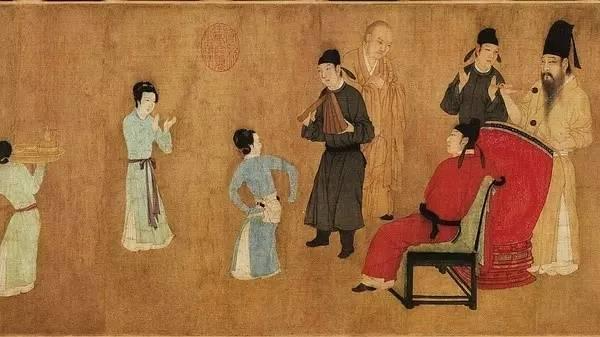
Night Banquet of Han Xizai·Watching Dance
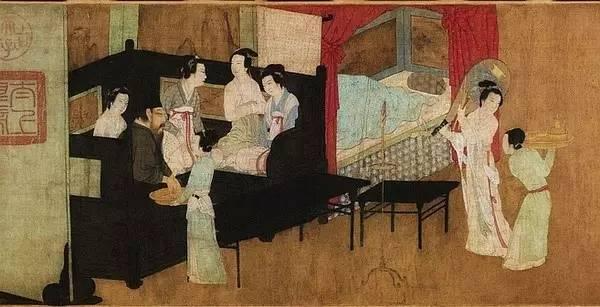
Night Banquet of Han Xizai· Pause

Night Banquet of Han Xizai·Qingchui
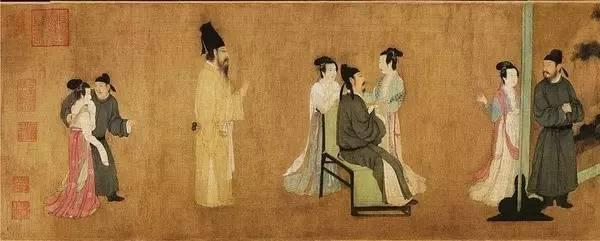
Night Banquet of Han Xizai: After the Banquet
If Zhou Wenju's "Playing Chess with a Double Screen" uses a folding screen to contrast the inner space and outer space of the scholar, then Wang Qihan's "Book Inspection " juxtaposes the scholar with a landscape folding screen, that is, the scholar's inner spiritual world and external material world coexist.
The landscape on the screen looks like the real world outside the transparent window, reflecting his inner world - leaving behind the daily tediousness and traveling in the mountains and forests. Perhaps the combination of various images in the painting can also suggest a narrative plot: the scholar is about to go on a long journey, and all the books and musical instruments he needs to bring have been packed and placed on the long table. He is sitting leisurely waiting to leave at any time, and the end of the journey is the thatched cottage in the center of the painting.
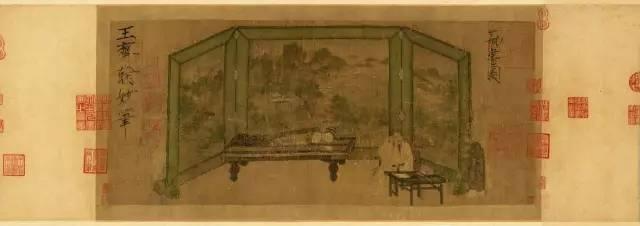
Book Survey
Five Dynasties/Wang Qihan/Color on silk
Hand scroll 28.4 cm long, 65.7 cm wide/Collection of Nanjing University
In the painting "Book Inspection", the scholar's left hand rests naturally on the armrest of the chair, and he raises his right hand to pick his ear. His face is slightly tilted to the right, and his left eye is slightly closed into a slit. The pleasure of picking his ear is vividly displayed on the plain silk. He is wearing a white shirt with his chest open, and his long beard hangs down softly in front of his chest. He sits with his legs crossed, and his bare feet are placed on his shoes, with his big toes upturned, which echoes and connects with the picking of his ear. A sense of leisure and comfort is vividly expressed. In addition, the background screen, the table and the servants are arranged appropriately, simple and generous, orderly, and the brushwork is smooth with pauses and changes.
In the Xuanhe Painting Album, Wang Qihan was distinguished from court painters, and he was described as a scholar-painter: "He painted Taoist and Buddhist figures in a refined manner, and liked to paint mountains, forests, hills, and valleys, hidden rocks and secluded places, without any trace of the dust of the city." He painted such themes as "Pictures of Noble Scholars", "Pictures of Ancient Sages", and "Pictures of Seclusion in Mountains and Rivers". His only work handed down to the present day, "Books Reading", reflects this scholar's taste.
Other classic works of screen painting
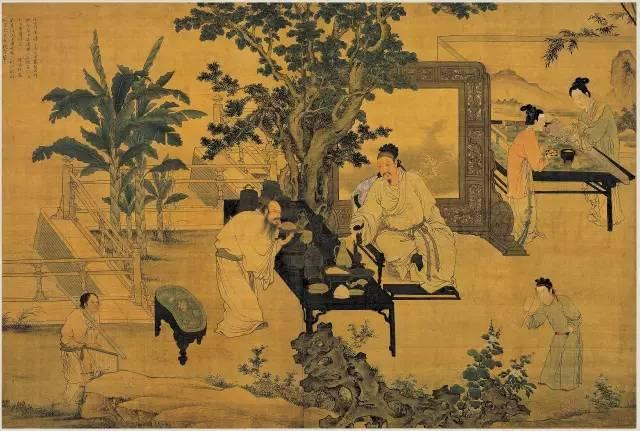
Ming/Du Jin/Antique Painting/Color on Silk 126.1×187cm
Collection of the National Palace Museum, Taipei
"Playing with Antiques" is a large double-panel painting. The original painting may have been mounted as a screen, just like the standing screen in the painting. In addition to appreciating ancient artifacts, the theme also describes the four recreational activities of literati, namely, playing the zither, chess, calligraphy, and painting. The painting style is elegant and simple, with a lingering charm of the Southern Song Dynasty court style. Du Jin's meticulous figure painting of this type had a profound influence on Tang Yin's style in the middle period.
'
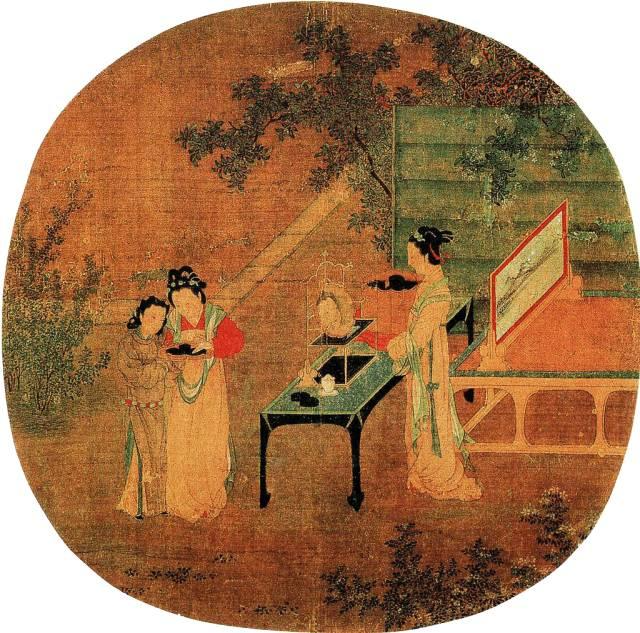
Northern Song Dynasty/Wang Shen, "Embroidered Mirror in the Morning"/Round Fan
Color on silk/24.2 cm in height, 25 cm in width
Collection of the National Palace Museum, Taipei